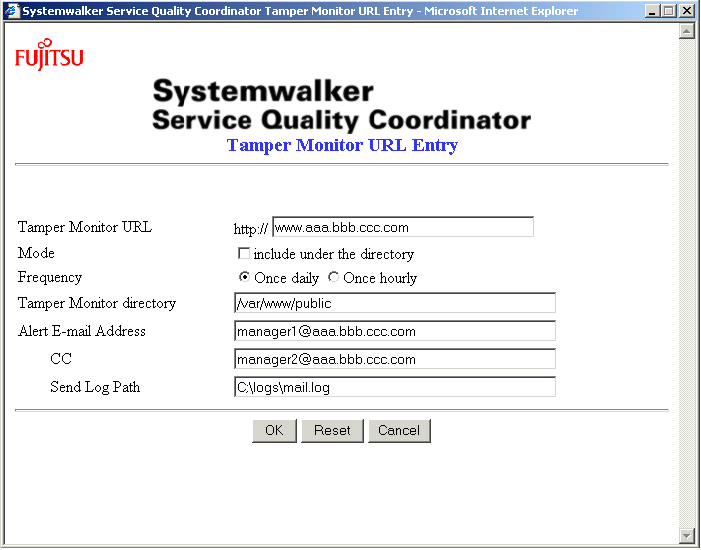The Tamper Monitor URL Entry window is used to register monitoring conditions.

Specify the URL of the content or the directory containing the content. If a directory is specified, the content right under the directory is to be monitored.
Specify the URL up to 1,023 characters excluding the following:
^ | [ ] { } < > ( ) & $ # " ' * , ?
Example 1: To specify content
http://www.fujitsu.com/index.html
Example 2: To specify a directory
http://www.fujitsu.com/
Point
The URL specified here is used as to represent monitoring conditions in the Contents Tampering Monitor window, Action Statement window and the detection notification.
If this check box is selected when a directory is specified in [Tamper Monitor URL], all contents under the directory are to be monitored.
Specify the frequency of tamper checking.
Specify the absolute path of the file or directory on the Web server machine corresponding to the URL specified in [Tamper Monitor URL].
Specify the path up to 1,023 characters excluding the following:
^ | [ ] { } < > ( ) & $ # " ' * , ?
[Windows]
Example 1: To specify a file
C:\www\index.html
Example 2: To specify a directory
C:\www
[UNIX]
Example 1: To specify a file
/var/www/index.html
Example 2: To specify a directory
/var/www
Specify only one E-mail address to which a tamper detection notification is to be sent.
Specify the E-mail address up to 1,023 characters excluding the following:
^ | [ ] { } < > ( ) & $ # " ' * , ?
Specify the E-mail address to which a copy of tamper detection notification is to be sent as needed. If two or more addresses are specified, delimit them with a semicolon(;).
Specify the E-mail address up to 1,023 characters excluding the following:
^ | [ ] { } < > ( ) & $ # " ' * , ?
Example: To specify two E-mail addresses
user1@fujitsu.com;user5@fujitsu.com
If the send log file for tamper detection notification is to be changed from the default to another, specify the absolute path of the new file.
Specify the path up to 1,023 characters excluding the following:
^ | [ ] { } < > ( ) & $ # " ' * , ?
The default send log file is as follows:
[Windows]
Example:
<Variable file storage directory>\etc\seq\log\send.log
[UNIX]
Example:
/etc/opt/FJSVssqc/seq/log/send.log
Point
The default send log file is renamed to send.log~ (past log is deleted) every time the amount of logged data exceeds a given level. The default log file thus contains only the recent log. To retain the past log, change the send log file from the default to another.